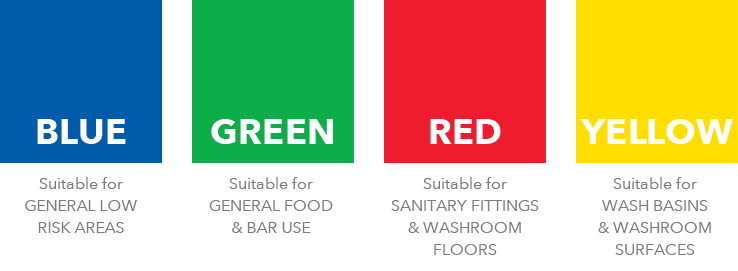Colour Coding

The Colour Coding information compliments the toilet cleaning guidance information , the Best Practise information and the information included in the Toilet Design, Toilet Ratios and Requirements and Clour Coding tabs.
Colour coding was introduced to reduce the risk of cross-contamination. The risk is of the same cloths and cleaning equipment were being used to clean high risk areas such as toilets and then the same items used for cleaning wash basins and other surfaces in a washroom, thus speading harmful germs to these areas.
The British Institute of Cleaning Science (BICSc) first began to develop a universal colour code which would be recommended for use for the cleaning industry. BICSc believes all materials within a hospital janitorial cupboard should be colour coded including; cloths, mops, buckets, aprons, and gloves. Over the years the BICSc has reviewed its recommendations to align with those from organisations such as the National Patient Safety Agency in the UK.
From 1 January 2006, a number of new food and hygiene legislations were applied to the UK. As good practice, the Food Standards Agency suggested that separate cleaning equipment such as cloths, sponges and mops, should be used in areas where ready-to-eat foods are stored, handled and prepared. Colour coding was introduced for cleaning equipment and materials to help prevent cross-contamination. This ensured that these items were not used in multiple areas, therefore reducing the risk of cross-infection.
In the UK alone, it has been estimated that there were as many as 50 difference colour coding schemes currently in use, mostly revolving around the same code colours but with different specific meanings. This presented a potential risk when staff moved from organisation to organisation, or even from site to site. A standardised code mitigates the risk of possible cross-contamination.
To ensure compliance with legislation, employers must ensure that their employees are fully trained in their role, this includes good knowledge of the colour coding system. By implementing the colour code system into the cleaning process, employers can ensure the safety of their cleaning operatives, their clients and other building users.


